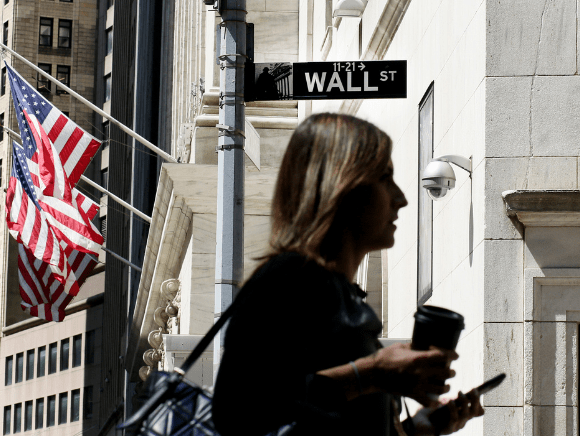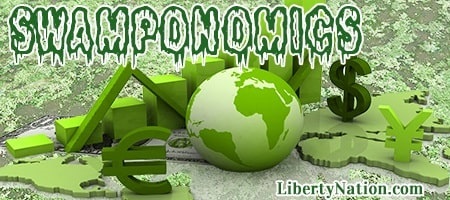
NEW YORK, NEW YORK – JULY 12: A woman walks near to The New York Stock Exchange, on July 12, 2022 in New York. Wall Street is back to falling amid recession, the S&P 500 closed 1.2% lower while tech stocks pushed the Nasdaq down 2.3%. (Photo by John Smith/VIEWpress)
The consensus on Wall Street is that a US recession is all but inevitable at this point. The debate among the smartest men and women is when and how severe. Aside from the sizzling labor market, which is showing signs of cooling down, the broader economy is turning sluggish amid skyrocketing price inflation, a crumbling stock market, and rising interest rates. But do not tell this to the White House, which is engaging in some Orwellian speak of not believing your eyes and ears.
White House Rejects US Recession Definition
White House Council of Economic Advisers chair Cecilia Rouse and member Jared Bernstein recently published a blog post, opining that even if the data show two consecutive quarters of negative growth, it does not mean the United States is in a recession, contradicting the standard National Bureau of Economic Research (NBER) definition.
 “Recession probabilities are never zero, but trends in the data through the first half of this year used to determine a recession are not indicating a downturn,” the White House wrote. “Looking ahead, we know that the U.S., along with the rest of the global economy, faces significant headwinds—and little relevant data are yet available on the third quarter (2022Q3).”
“Recession probabilities are never zero, but trends in the data through the first half of this year used to determine a recession are not indicating a downturn,” the White House wrote. “Looking ahead, we know that the U.S., along with the rest of the global economy, faces significant headwinds—and little relevant data are yet available on the third quarter (2022Q3).”
Let’s take a look at some of the numbers the administration is utilizing to dismiss recession talk. Industrial production rose 0.8% in April, flatlined in May, and tumbled 0.2% in June. Real personal income edged up just 0.5% in April and May. Once again, the only robust component of the Biden economy is the jobs market, but this is beginning to unwind.
As the World Tightens, Russia Cuts
Russia’s central bank slashed its benchmark interest rate by 150 basis points, defying most market expectations. The institution lowered its key rate from 9.5% to 8%, leaving market experts stunned as they anticipated a half-point reduction. This represented the fifth rate cut by the organization so far this year, following an astonishing 10.5% rate hike in February after the invasion of Ukraine.
“The external environment for the Russian economy remains challenging and continues to significantly constrain economic activity,” the Central Bank of Russia (CBR) said in a statement, adding that inflation is poised to slow down even further because of “the influence of a set of one-off factors and the subdued consumer demand.”

Vladimir Putin (Photo by Contributor/Getty Images)
Surprisingly, the Russian economy has performed better than what the West had expected at the beginning of the military conflict in Eastern Europe. The purchasing managers’ index (PMI) readings remain in expansion territory, Moscow is experiencing deflation (the producer price index fell 6.9% in May, and the consumer price index slipped 0.35% in June), and foreign exchange reserves remain steady at around $584 billion.
As Liberty Nation has been reporting, Russia’s President Vladimir Putin has secured critical economic and strategic trade agreements with multiple foreign markets, including China, India, and Saudi Arabia. Moscow’s resilient energy sector is producing and selling more oil and gas than prior to the war, plus its revenues are projected to increase approximately 20% from a year ago. Despite the panoply of sanctions and restrictions, nothing seems to be slowing down the Russian economy – for now.
July Not Looking Good
Some of the July economic reports are not looking bright for the US economy in the third quarter, contrary to what the brilliant minds on 1600 Pennsylvania Avenue purport. While long-term trends are far more important than snapshots, the latest numbers can offer investors, consumers, and businesses a glimpse of what to expect in the second half of 2022. So, what data flashed a red light? Let’s take a look.
The S&P Global US Manufacturing Purchasing Managers’ Index tumbled to 52.3 this month, down from 52.7 in June – anything above 50 indicates expansion. This represented the slowest growth in manufacturing activity in two years, driven by unchanged output levels, sliding new order inflows, elevated price inflation, and weak employment growth. Business sentiment in this sector was also the lowest since October 2020. The S&P Global’s Composite and Services PMIs contracted in July, coming in at 47.5 and 47, respectively. These indexes recorded the same developments: lackluster production, new orders, and employment, with a side of high prices.
This is comparable to the Federal Reserve Bank of Philadelphia’s Manufacturing Index which plummeted to -12.3 in July, down from -3.3 in the previous month. Economists had anticipated a flat reading. Business conditions, capital expenditures, new orders, and employment weakened considerably.
 On the labor front, the number of Americans filing for unemployment claims rose every week so far in July, according to the Bureau of Labor Statistics (BLS). Initial jobless claims also advanced to a nine-month high of 251,000 in the week ending July 16. Continuing jobless claims climbed to 1.384 million, while the four-week average, which removes week-to-week volatility, increased once again to 240,500.
On the labor front, the number of Americans filing for unemployment claims rose every week so far in July, according to the Bureau of Labor Statistics (BLS). Initial jobless claims also advanced to a nine-month high of 251,000 in the week ending July 16. Continuing jobless claims climbed to 1.384 million, while the four-week average, which removes week-to-week volatility, increased once again to 240,500.
These numbers may need to be filed away somewhere since all eyes will be on the upcoming second-quarter gross domestic product (GDP) growth rate. Economists forecast a 0.4% expansion in the April-June period, but the Fed Bank of Atlanta’s GDPNow model estimate is penciling in a 1.6% decline. Either projection is not great for the United States since one would indicate recession, and the other would spotlight stagflation – a bout of stagnating growth and high inflation. Brace yourselves, the hot takes will be coming in fast from the White House.
Remember to check out the web’s best conservative news aggregator
Whatfinger.com — the #1 Alternative to the Drudge


